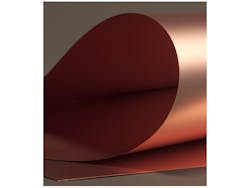Circuit Materials Help Build 5G from the Ground Up
Download this article as a .PDF
Large amounts of bandwidth will be needed for transferring the huge volumes of data projected to be part of 5G wireless networks, and millimeter-wave frequencies offer the amounts of bandwidth needed. Of course, to make use of that bandwidth at frequencies such as 60 GHz, practical circuits including transceivers, antennas, and amplifiers must be designed and implemented, and the foundation of those circuits is the printed-circuit-board (PCB) material. For effective use at millimeter-wave frequencies, a PCB material must fulfill a set of requirements that can be unique to that frequency range (above about 30 GHz). Fortunately, the latest high-frequency circuit material from Rogers Corp., CLTE-MW laminates, features the characteristics uniquely suited to millimeter-wave applications.
CLTE-MW circuit materials (see figure) are based on low-loss polytetrafluoroethylene (PTFE), loaded with ceramic filler and reinforced with spread glass fabric. Offered in thicknesses of 3, 4, 5, 6, 7, 8, and 10 mils, CLTE-MW materials are well suited for circuits requiring thin laminates, such as millimeter-wave circuits with extremely short signal wavelengths that require tightly controlled dielectric constant and signal-to-ground spacing.
Material Requirements
Millimeter-wave frequencies are being looked upon for backhaul and other short-range communication links within 5G systems. In addition to being affordable, the circuit materials for such applications must meet a number of challenges resulting from the short wavelengths and limited energy available at millimeter-wave frequencies. Antennas for 5G networks, for example, are expected to employ large multiple-input, multiple-output (MIMO) arrays of elements which will be fabricated on multilayer circuit boards requiring low loss, low dielectric constant (Dk), and stable electrical and mechanical properties to achieve consistency among the many antenna elements.
CLTE-MW laminates meet these requirements with typical Dk values ranging from 2.94 to 3.05 at 10 GHz (depending upon the thickness of the material), held to a tolerance of ±0.04. For example, 3-mil-thick CLTE-MW laminate exhibits a process Dk of 2.94 at 10 GHz while 10-mil-thick material has a process Dk of 3.00. The design Dk values (used with circuit simulators as part of the design process) are slightly higher than the process Dk values for all thicknesses.
As a function of temperature (thermal coefficient of dielectric constant), the Dk changes only by -35 ppm/ºC from 0 to +100ºC as measured at 10 GHz. The loss tangent is a low 0.0015 at 10 GHz, to preserve the limited signal energy at millimeter-wave frequencies. When signal power is available, these materials provide the capability to handle higher signal power levels, with a thermal conductivity of 0.42 W/m-K through the thickness (z-axis) of the material.
An important material specification for circuits in which considerable power is generated or transferred, such as amplifiers and transmit antennas, is coefficient of thermal expansion (CTE). CTE indicates the dimensional changes in a circuit material with changes in temperature. For the CLTE-MW laminates, the z-axis CTE is 30 ppm/ºC, representing very little change in thickness with temperature—especially important for multilayer circuits and circuits with structures such as plated through-holes which can become mechanically stressed with dimensional changes. The CTE in the x and y axes is typically 8 ppm/ºC. These relatively thin circuit materials exhibit high dielectric strength of 630 V/mil for high isolation between conductor layers in multilayer circuit designs. Also, high stability under less-than-ideal operating conditions is evidenced by low moisture absorption of 0.03%.
In addition to 5G, the CLTE-MW materials are candidates for commercial, industrial, and military microwave and millimeter-wave applications, including automotive radar systems. The UL94 V-0 flammability rating makes them well suited for commercial use. Along with the choices of circuit material thicknesses, the laminates can be supplied with rolled copper foil, reverse-treated electrodeposited (ED) copper, and standard ED copper foil. CLTE-MW materials are also available upon request with resistive foil and metal plates for ideal heat spreading.
Rogers Corp., Advanced Connectivity Solutions, 100 S. Roosevelt Ave., Chandler, AZ 85226; (480) 961-1382
About the Author
Jack Browne
Technical Contributor
Jack Browne, Technical Contributor, has worked in technical publishing for over 30 years. He managed the content and production of three technical journals while at the American Institute of Physics, including Medical Physics and the Journal of Vacuum Science & Technology. He has been a Publisher and Editor for Penton Media, started the firm’s Wireless Symposium & Exhibition trade show in 1993, and currently serves as Technical Contributor for that company's Microwaves & RF magazine. Browne, who holds a BS in Mathematics from City College of New York and BA degrees in English and Philosophy from Fordham University, is a member of the IEEE.


